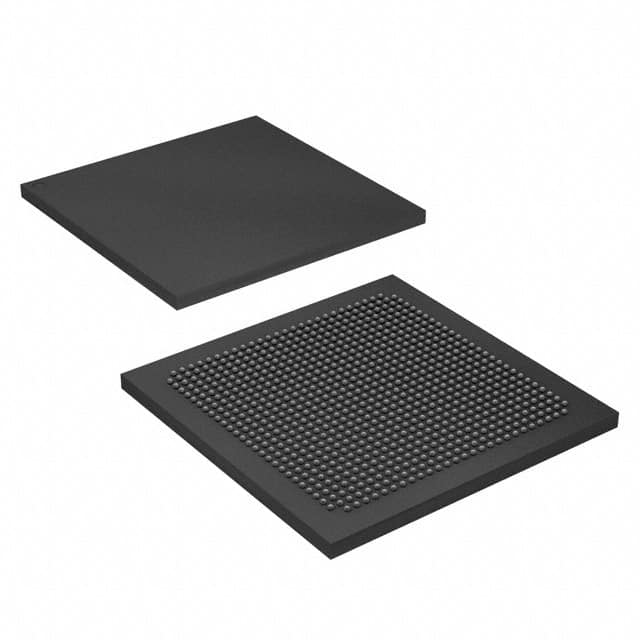EP3SL200H780C4LN
Product Overview
- Category: Programmable Logic Device (PLD)
- Use: EP3SL200H780C4LN is a high-performance PLD designed for various applications in the field of digital logic design and implementation.
- Characteristics: This PLD offers advanced features such as high-speed performance, low power consumption, and flexible programmability. It comes in a compact package with excellent reliability and durability.
- Package: EP3SL200H780C4LN is available in a 780-pin ceramic land grid array (CLGA) package.
- Essence: The essence of EP3SL200H780C4LN lies in its ability to provide a versatile and efficient solution for complex digital logic designs.
- Packaging/Quantity: Each EP3SL200H780C4LN unit is packaged individually and is available for purchase as a single unit.
Specifications
- Logic Elements: EP3SL200H780C4LN consists of 200,000 logic elements, which can be configured to perform various logical operations.
- Memory Capacity: It offers a memory capacity of 4,500 kilobits, allowing for storage and retrieval of data during operation.
- Clock Frequency: EP3SL200H780C4LN supports a clock frequency of up to 400 MHz, enabling high-speed processing of digital signals.
- I/O Pins: This PLD provides a total of 780 I/O pins, allowing for seamless integration with external devices.
- Operating Voltage: EP3SL200H780C4LN operates at a voltage range of 1.2V to 3.3V, providing flexibility in different power supply scenarios.
Pin Configuration
The detailed pin configuration of EP3SL200H780C4LN can be found in the manufacturer's datasheet.
Functional Features
- Flexible Programming: EP3SL200H780C4LN can be programmed to implement a wide range of digital logic functions, making it suitable for diverse applications.
- High-Speed Performance: With its support for clock frequencies up to 400 MHz, this PLD ensures efficient and rapid processing of digital signals.
- Low Power Consumption: EP3SL200H780C4LN is designed to minimize power consumption, making it an energy-efficient choice for various applications.
- Reliability and Durability: The PLD's compact package and high-quality construction ensure excellent reliability and durability in demanding environments.
Advantages and Disadvantages
Advantages: - Versatile programmability - High-speed performance - Low power consumption - Reliable and durable construction
Disadvantages: - Limited memory capacity compared to some other PLDs on the market - Higher cost compared to lower-end PLDs
Working Principles
EP3SL200H780C4LN operates based on the principles of programmable logic. It consists of configurable logic elements that can be interconnected to perform desired logical operations. These logic elements are programmed using specialized software tools, allowing designers to create custom digital logic designs. During operation, the PLD processes input signals according to the programmed logic, producing the desired output results.
Application Field Plans
EP3SL200H780C4LN finds applications in various fields, including but not limited to: - Telecommunications - Industrial automation - Automotive electronics - Consumer electronics - Medical devices
In telecommunications, it can be used for signal processing, protocol conversion, and network management. In industrial automation, it enables control and monitoring of complex systems. In automotive electronics, it contributes to advanced driver assistance systems (ADAS) and vehicle control units. In consumer electronics, it supports multimedia processing and data storage. In medical devices, it aids in diagnostic imaging and patient monitoring.
Alternative Models
- EP3SL150H780C4LN: A lower-cost alternative with slightly reduced logic elements and memory capacity.
- EP3SL400H780C4LN: A higher-end alternative with increased logic elements and memory capacity for more demanding applications.
- EP3SL200F484C4N: An alternative model with a different package and pin configuration, suitable for specific design requirements.
These alternative models offer varying features and specifications to cater to different application needs.
Senaraikan 10 soalan dan jawapan biasa yang berkaitan dengan aplikasi EP3SL200H780C4LN dalam penyelesaian teknikal
Sure! Here are 10 common questions and answers related to the application of EP3SL200H780C4LN in technical solutions:
Q: What is EP3SL200H780C4LN? A: EP3SL200H780C4LN is a specific model of Field-Programmable Gate Array (FPGA) manufactured by Intel.
Q: What are the key features of EP3SL200H780C4LN? A: EP3SL200H780C4LN offers high-density programmable logic, embedded memory blocks, high-speed transceivers, and support for various I/O standards.
Q: In which technical solutions can EP3SL200H780C4LN be used? A: EP3SL200H780C4LN can be used in a wide range of applications such as telecommunications, industrial automation, video processing, and high-performance computing.
Q: What advantages does EP3SL200H780C4LN offer over other FPGAs? A: EP3SL200H780C4LN provides high performance, low power consumption, flexibility, and scalability, making it suitable for demanding applications.
Q: How can EP3SL200H780C4LN be programmed? A: EP3SL200H780C4LN can be programmed using Hardware Description Languages (HDLs) like VHDL or Verilog, or through graphical programming tools provided by Intel.
Q: Can EP3SL200H780C4LN interface with other components or devices? A: Yes, EP3SL200H780C4LN supports various communication protocols and interfaces such as PCIe, Ethernet, USB, SPI, I2C, and more.
Q: What kind of development tools are available for EP3SL200H780C4LN? A: Intel provides Quartus Prime, a comprehensive development software suite that includes design entry, synthesis, simulation, and programming tools for EP3SL200H780C4LN.
Q: Are there any reference designs or application notes available for EP3SL200H780C4LN? A: Yes, Intel offers a wide range of reference designs and application notes to help developers get started with EP3SL200H780C4LN in different applications.
Q: Can EP3SL200H780C4LN be used in safety-critical systems? A: EP3SL200H780C4LN can be used in safety-critical systems, but additional measures like redundancy and fault-tolerant design should be considered to meet the required safety standards.
Q: Where can I find more information about EP3SL200H780C4LN? A: You can find detailed information, datasheets, user guides, and other resources on Intel's official website or by contacting their technical support team.


